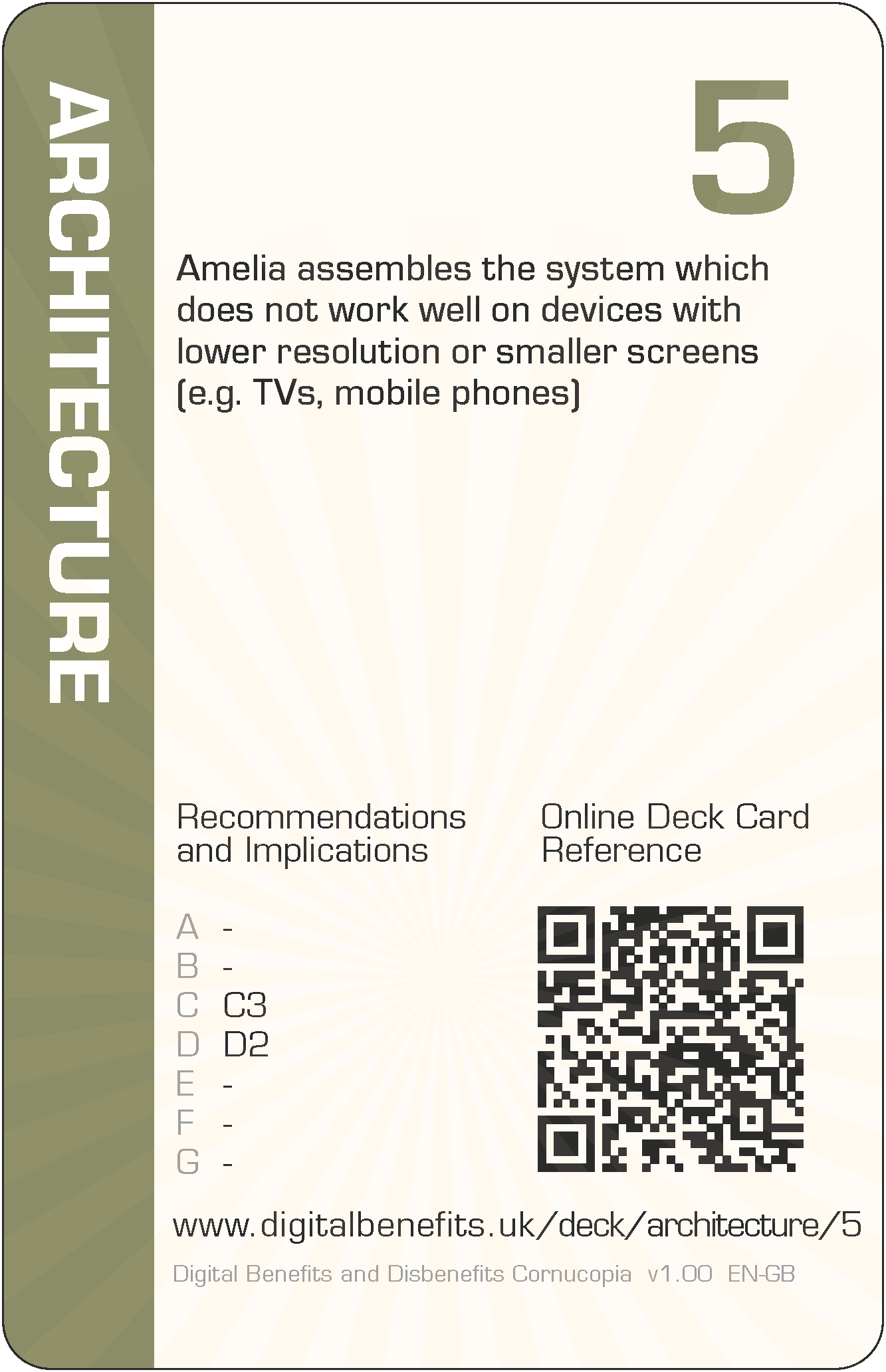Architecture 5 (AR-5) Card
DBD Cornucopia > Deck > Architecture > 5
Card Details - Five of Architecture
Abbreviation
AR-5
Card's focus
The focus of this card is screen resolution
Threat to claimants
Amelia assembles the system which does not work well on devices with lower resolution or smaller screens (e.g. TVs, mobile phones)

Threat to claimants
Amelia assembles the system which does not work well on devices with lower resolution or smaller screens (e.g. TVs, mobile phones).
Some examples of how this threat could lead to harms (negative effects on claimants)
The design recommendations and implications relevant to the card are listed below in the next section, but even those can be somewhat abstract and difficult to think about during practical day-to-day implementation. Therefore, some example harms are provided to complement the more formal research outputs. These examples are unique per card, and are only published on these web pages (i.e. in no other project outputs).
- Claimants find text input very fiddly, leading to more mistakes, typos and shorter responses which can affect their award
- On some screens, claimants find it harder to see all the navigation and options, leading to the wrong forms being used to submit requested information, and subsequent delays, over-payments or penalties
The examples are to help understand the threat on the card, not to suppress thinking and innovation. Incorporating these examples exactly, or closely matching ones, should be scored down when playing DBD Cornucopia as a game.
Applicable design recommendations and implications
These are reproduced here from Research Briefing N
Reduce claimants’ interaction burdens with digital welfare
- Provide full social protection services across wider interoperable channels
Ensure all service provision and modes of assistance (e.g., provision of advice, practical support and self-help guidance) are available through multiple interaction channels (e.g., telephone, web, mobile app) which are accessible to varying resources and capabilities (e.g., communication skills, equipment, language, physical and mental abilities). Permit the use and intermixing of channels without restriction. Consider providing on-demand synchronous interactions through digital as well as other channels.
Embrace a wider ecosystem and fuller claimant activity viewpoint for digitised public services
- Design for the needs of claimants’ lives covering their expansive activities
Recognise that service take-up requires more than direct interactions with the state. Ensure design is not restricted to service delivery between interaction points of claimants and the state within a 'user journey', and instead span all actors and mediating instruments that come together to achieve the claimant's goal.
General Notes
Card values (i.e. '5' for this card) are for game play and are not correlated with the severity of harm. This is because threats cannot be ranked directly since they can affect individuals in different ways due to situations and circumstances, or affect fewer or more claimants, or the harms can arise in claimants' support networks and wider society.
The threat description uses a person's name as the "attacker" (i.e. 'Amelia' for this card), which can be thought of someone involved with implementation. They could have any role which influence digitisation. So they could be a database administrator, or a copy writer, or a quality assurance specialist, etc, or all of these. Everyone could have some influence on the claimant threat described. The names were randomly selected from those currently most popular as given names for boys and girls (UK Office for National Statistics).
The example harms provided are drawn from the research data (which explored not only parts of existing services but also the effects of possible changes to those), from the author's own knowledge of web application development and testing, the author's own experience of helping citizens to claim Universal Credit (UC) and Personal Independence Payment (PIP), and from suggestions submitted by other people (make a suggestion). The threats and example harms do not necessarily exist in the current UC or PIP deployments or in ecosystems around those services, but they might well do.
All the cards in this Architecture suit are: 2 3 4 5 6 7 8 9 10 J Q K A
The other suits in the deck are: Scope, Agency, Trust, Porosity and Cornucopia (plus Jokers).
